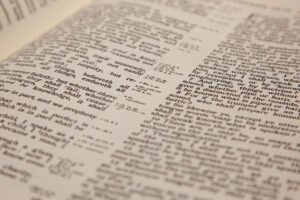Are Today’s Gospels the Same as the Originals?
Gospel manuscript evidence dates back to the lifetimes of the Disciples with a fragment of Matthew dating as early as 50 AD, just 10 years after the crucifixion of Jesus. Earliest of the nearly complete Gospel manuscripts are dated about 300 years later.[1] How can there be confidence today’s Gospels bare the same content as the originals?

Patristics is the science of comparing early Christian writings to Gospel manuscripts in an effort to bridge the gap of the “dark period” – the 300 year gap from the originals to the first complete manuscripts.
Writings or letters called “Epistles” were a common means of written communication by second and third generation disciples known as the Ante-Nicene Fathers.[2] Within these Epistles are quoted phrases and verses that also appear in today’s Gospels.
As a basis of fact, these phrases and verses had to come from older, preexisting Gospel sources. As such, they serve as “witnesses” that attest or testify to the content of older, now non-existent Gospel manuscripts, in some cases quite possibly the originals.[3]
Expert Bible textual critics, Westcott and Hort, viewed patristics to be of “the highest degree exceptional” in their comparisons.[4] Four Epistle author sources – Clement of Rome, Ignatius, Polycarp, and Papias – personally knew some of the Apostles, the original Disciples of Jesus.[5]
Clement of Rome authored The First Epistle of Clement to the Corinthians written in Rome to the church in Corinth, Greece, around 96 AD. It is named for Clement who studied under the Apostle Paul and knew Luke, the presumed author of the Gospel bearing his name.[6]
Another is The Epistle of Polycarp to the Philippians written in Smyrna, Turkey, to the church in Philippi, Greece. Named for its author, Polycarp was a disciple of the Apostle John, one of the original Disciples of Jesus and the presumed author of that Gospel.
Polycarp received teaching from the Apostle John as well as other Apostles and met others who had witnessed the ministry of Jesus. Date of authorship is unknown although it had to be written before Polycarp’s martyrdom in the arena of Smyrna about 155 AD. At his execution, Polycarp professed to have served his King (Jesus) for 86 years, was burned alive by Rome in 156 AD.[7]
An example of how patristics work can be seen using the three verses of Luke 6:36-38 which are quoted in both the Epistles of Clement, Corinthians, and Polycarp, Philippians, two authors who were separated by time and hundreds of miles. Their quotes are compared with two current-day Bible translations:[8]
The First Epistle of Clement to the Corinthians [9]
“forgive, that it may be forgiven to you; as ye do, so shall it be done unto you;
as ye judge, so shall ye be judged; as ye are kind, so shall kindness be shown to you;
with what measure ye mete, with the same it shall be measured to you.”
Epistle of Polycarp to the Philippians [10]
“Judge not, that ye be not judged;
forgive, and it shall be forgiven unto you;
be merciful, that ye may obtain mercy;
with what measure ye mete, it shall be measured to you again…”
King James Version, Luke 6:36-38:
Be ye therefore merciful as your Father also is merciful, v36
Judge not and ye shall not be judged…v 37
…forgive and ye shall be forgiven.v37
For with the same measure that ye mete withal it shall be measured to you again.v38
New American Standard Bible: Luke 6:36-38:
Be merciful just as your Father is merciful…v36
Do not judge, and you will not be judged…v37
…pardon and you will be pardoned. v37
…For by your standard of measure it will be measured to you in return.v38
Attestations from Corinthians and Philippians Epistles are not word perfect matches, but neither are the more modern KJV and NASB translations. Both Epistles referenced Luke to support the message of their letters that match very closely even though the quotes were not intended to be a transcription of Luke’s Gospel.[11]
A treasure trove of patristic attestation appears in Adversus Haereses (Against Heresies) written about 180 AD by Irenaeus, a disciple of Polycarp. The writing quotes from over 600 verses in all four Gospels and over 300 verses from other New Testament books.[12] To be able to quote these verses, Irenaeus had to be referencing existing sources.[13]
Patristics has a secondary consequence – producing evidence that challenges a theory alleging the Gospels and Christianity evolved from legend over a long period of time.[14] Lack of historical sources to validate the aspects of a potentially legendary story and the time span required to develop a “legend” are both refuted by the science of patristics.
Do the Gospel verses quoted in the Epistles written by early church leaders provide strong evidence that today’s Gospel content is consistent with the original manuscripts?
Updated May 6, 2024.

This work is licensed under a Creative Commons Attribution-NonCommercial-NoDerivatives 4.0 International License.
REFERENCES:
[1]“The Magdalen Papyrus P64: possibly the earliest known fragments of the New Testament (or of a book!)” University of Oxford | Magdalen College. 30 October 2013. <http://www.magd.ox.ac.uk/libraries-and-archives/treasure-of-the-month/news/magdalen-papyrus> “The Magdalen P64 Papyrus Fragments of the Gospel of Matthew (Year ~ 50 A.D.).” Archaeology. <http://www.lavia.org/english/archivo/magdalenen.htm> Smith, Ben C. “Gospel manuscripts – The manuscripts extant for the four canonical gospels.” TextExcavation.com. 13 Jan. 2014. <http://www.textexcavation.com/gospelmanuscripts.html>
[2] Richardson, Cyril C. “Early Christian Fathers.” Christian Classics Ethereal Library. <http://eaglemissions.org/wp-content/uploads/2012/05/fathers.pdf>
[3] “Patristics.” Merriam-Webster. 2017 <http://www.merriam-webster.com> Gloag, Paton J. Introduction to the Synoptic Gospels. <http://catalog.hathitrust.org/Record/008728595> Foster. “Quotations in the Apostolic Fathers.”
[4] Westcott, Brooke F. & Hort, John A. The New Testament in the Original Greek. “Introduction.” CR page 112. https://books.google.com/books?id=0xtVAAAAMAAJ&pg=ACfU3U33CMW3331Vv20NgGvjyOs52I1mlA&vq=%22will+not+be+out+of+place+to+add+here+a+distinct+expression+of+our+belief+that+even+among+the+numerous%22&source=gbs_quotes_r&cad=2_0#v=onepage&q&f=false>
[5] Foster, Lewis. “Quotations in the Apostolic Fathers.” The Cincinnati Bible College & Seminary. 1969. Volume XV — Number 4. <http://www.dabar.org/SemReview/v15n4-Fathers.htm#N_23_>
[6] Richardson. “Early Christian Fathers.” Schaff, Philip. “Introductory Note to the First Epistle of Clement to the Corinthians.” Christian Classics Ethereal Library. 13 July 2005. <http://www.ccel.org/ccel/schaff/anf01.ii.i.html> Schaff. “Introductory Note to the Epistle of Polycarp to the Philippians.” Christian Classics Ethereal Library. 2005. <http://www.ccel.org/ccel/schaff/anf01.ii.i.html>
[7] Schaff, Philip. “Introduction Note to the Epistle of Polycarp to the Philippians.” Kirby, Peter. “The Martyrdom of Polycarp.” Early Christian Writings. 2017. <http://www.earlychristianwritings.com/martyrdompolycarp.html>
[8] Kirby, Peter. “Gospel of Luke.” EarlyChristianWritings.com. <http://www.earlychristianwritings.com/luke.html> Kirby, Peter. “Gospel of Mark.” EarlyChristianWritings.com. <http://www.earlychristianwritings.com/mark.html>
[9] Clement of Rome (aka Clement I). “The First Epistle of Clement to the Corinthians.” Classics Ethereal Library. 2005. <http://www.ccel.org/ccel/schaff/anf01.ii.ii.html>
[10] Polycarp. “The Epistle of Polycarp to the Philippian.” Christian Classics Ethereal Library. <http://www.ccel.org/ccel/schaff/anf01.iv.ii.html> Davis, Glen. “Polycarp of Smyrna.” NTCanon.org. 2008. <http://www.ntcanon.org/Polycarp.shtml> Lake, Kirsopp. “Polycarp to the Philippians.” EarlyChristianWritings.com. <http://earlychristianwritings.com/polycarp.html>
[11] Polycarp. “The Epistle of Polycarp to the Philippian.”
[12] Davis, Glen. “Irenaeus of Lyons.” NTCanon.org. 25 July 2008. <http://www.ntcanon.org/Irenaeus.shtml> Encyclopædia Britannica. 2021. <https://www.britannica.com/biography/Saint-Irenaeus>
[13] Irenaeus of Lyons. Against Heresies. Schaff, Philip. “Introductory Note to Irenæus Against Heresies.” Christian Classics Ethereal Library. <http://www.ccel.org/ccel/schaff/anf01.ix.i.html> Schaff, Philip. “Introduction Note to the Epistle of Polycarp to the Philippians.” Goodspeed, Edgar J., “Irenaeus. Proof of The Apostolic Preaching.” Ante Nice Fathers. 2014. <http://antenicenefathers.org/irenaeus> Davis, Glen. “Irenaeus of Lyons.” Westcott & Hort. The New Testament in the Original Greek. Introduction; pages 113, 194-195. Gloag. Introduction to the Synoptic Gospels. “General Introduction.”
[14] Rochford, James M. Evidence Unseen. Legend Theory: “The resurrection was a legend that grew over time.” n.d. <https://www.evidenceunseen.com/christ/defending-the-resurrection/legend-theory-the-resurrection-was-a-legend-that-grew-over-time> Billingsley, Greg. “Alternate Theories To The Resurrection – The Legend Theory.” 2012. <http://etheology.com/blogs/greg-billingsley/alternate-theories-to-the-resurrection-the-legend-theory>
